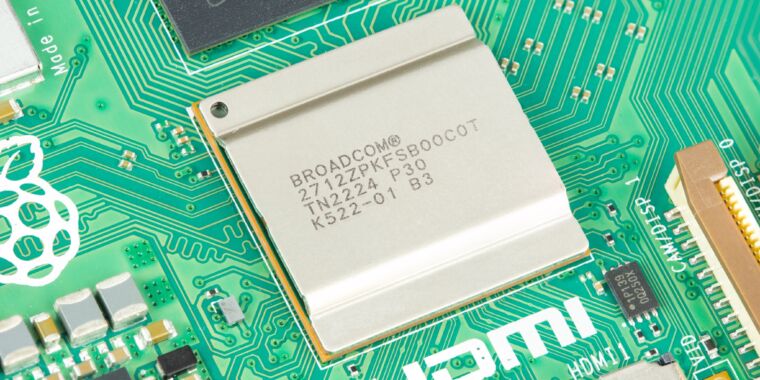- cross-posted to:
- raspberrypi@lemmy.ml
- cross-posted to:
- raspberrypi@lemmy.ml
deleted by creator
It’s a tough call, because while their decision to go IPO sucks, they’re one of the few SBCs with consistent kernel support.
I’ve heard about a lot of headaches people have with other SBCs due to lack of support.
As much as the Pi Foundation sucks noodles, the levels of software support for the Pi is currently unequaled.
Anyway, here’s hoping it gets equaled, and fast.
What really bothers me is that rpi seems to have “lost its way”.
I’d argue, there are essentially two camps here. The close-to-x86 camp, who want powerful, but efficient small machines, and the tinker-board camp, who want cheap machines with barely any power needs, basically a microcontroller on steroids, that you can buy an entire school class worth of for a few bucks.
Rpis started in the latter camp. 35€ for reasonable performance, great software for kids to tinker with, hardly any requirements, everyone has a usb mouse/keyboard.
But nowadays pis are in the no man’s land between. They’re priced above cheap N100 PCs, but are not as powerful, and simultaneously way too expensive and involved for throwing them at children - like it was initially intended.
I’m not sure, how that’s supposed to be sustainable.
Industrial applications… This is now their market, not tinkerers.
They are too slow and unreliable for the industrial market though. If you have money you can just buy X86.
Industrial is not all high tech or efficiency driven.
It’s about cost and availability. They probably buy in bulk, have some Linux image with the exact setup they need. Then they just replace them if they break with little to no downtime.
For smaller bulk-use applications there’s microchips like ESP or Teensy. For larger applications there’s X86.
For a cost effective pi alternative there’s Rockchip stuff.
There are tons of them in the industrial market. The entire shortage of them was from prioritizing the industrial market.
The entire shortage was because of Covid19
And then putting the shortfall into the industrial market, which is an important fact when countering the idea that Pi’s aren’t used in the industrial market.
They have fulfilled their mission with the first Raspbi, everything after is extra.
The pi3B+ and pi4B are still $35 for the 1GB models and have the same performance today that they did when they came out (and way more compatible software).
If all you’re doing is setting up a tinkering lab at a school, which everyone and their mom seems to want to do judging by the comments, you can still do that. The only thing that has changed is the entry of the sbc choices. Raspberry pi hasn’t gotten worse, the market has just caught up with them to some degree and that’s fine.
Maybe it’s just them not being sold here officially, bit I have NOT seen those for $35. They’re all closer to $100.
I literally just went to the links provided by the Buy Now buttons on the raspberry pi website and they’re all there.
I feel like there’s a Mandela effect thing going on with how people remember the price of pis several years ago. If anything, because of inflation, pis are cheaper now than when they released.
Well, “buy now” would not work here, that’s the point. Neither of the resellers listed (one does indeed list the low price) ships here.
Oh my god. Where are you located? I’ll literally look it up for you.
FFS.
That’s definitely true but pretty much you can buy some x64 mini PC for a very similar price, and also similar power consumption that is going to be more versatile and powerful. For example you can run some VMs etc. on top of it. The only benefit of the Rpi nowadags is only their form factor.
Can you link me to a new x86 mini PC for $50-$80?
For 70€ you can buy an N4000 mini PC with 6Gb of RAM, and 128Gb eMMC. This is just an example from AliExpress. I am not going to post a link here, but I believe you can find even more offers. Additionally, you can buy some thin clients second hand for dirt cheap.
With the right power supply and BIOS optimisation you can bring their power consumption to be comparable to the power consumption of the Pi, and would be a lot more versatile and powerful as a home/media/automation setup.
Yeah the support is what pulls me to them but anymore unless I need the form factor of the pi it’s hard to justify them. Like the only place I see a hobbyist use for the Pi is 3d printers. Outside of that everything else seems like a small form factor desktop is better.
Support is what makes me worry about Milk-V and their flood of RISC-V products. You see videos where somebody is trying to get Ubuntu working on Mars while using some colorful language or how the same guy purchased two Meles which were DOA and it makes me wonder how thinly spread their support must be. Or perhaps how packed the Pi Foundation and community support must be.
More for the rest of us, I guess.
Cross-post comment:
Geerling also demonstrated that the 2GB Pi 5 comes with a couple of unexpected benefits that Upton didn’t mention in his announcement—that the 2GB Pi 5 runs a little cooler and uses a little less power than the 4GB and 8GB editions. The 2GB Pi used just 2.4 W or power at idle and 8.9 W during a CPU stress test, compared to 3.3 W and 9.8 W in the 4GB version. The SoC of the 2GB Pi measured 30° Celsius at idle and 59° under load, compared to 32° and 63° for the 2GB version. Those are all small but significant differences, given that nothing has changed other than the SoC.
As to the exact functionality that was removed from the chip for the 2GB version of the Pi, the company hasn’t gotten specific. But Geerling speculates that it’s mostly related to functionality that’s being handled by the custom RP1 I/O chip—RP1 handles the Ethernet and USB controllers, display interfaces, and GPIO, among other things.
So is it worth stepping down to a 2 GB Pi 5 just to get the simpler D0 chip? No. But is it cool to have a cheaper 2 gig option exist? Yes. Just make sure you have a use case for it that doesn’t need a ton of RAM.[1]
It’s curious that things went this way. Broadcom originally made these chips for the cheapass end of the tablet market, but I thought RPi was gobbling up the entire supply. Why put in those features in the first place when the Pi5 wasn’t going to use them?
Does it still require the stupid 5V5A power adapter?
Yeah wrf was that? Even the risc64 visionfive2 used usbpd properly.
It’s 2024 and we live in a society.
Seems to be a constant problem with the Rasbperry Pi Foundation designs. They’ve often screwed up their power design.
Not that using shitty old phone chargers was ever going to work, but it should never have been as picky as it was.
The Pi 5 doesn’t require 5v 5amp. You just get limited power on downstream USB devices (like max 1 or 0.5 amp, not really that bad). It will run just fine on 3 amp PSU.
It will not. It needs 5a under load. Else there would not be a 5a PSU required.
https://www.raspberrypi.com/documentation/computers/getting-started.html
Raspberry Pi 5 5V/5A, 5V/3A limits peripherals to 600mA
5 amp is not a requirement, just a suggestion.
5amp is a requirement. It will crash under load without it.
I know because I have personally experienced this.
Something is wrong with either your power supply, the cable, or the pi itself. Are you running any hats or any extra hardware? Mine runs just fine on a 3 amp power supply under full load.
Nothing but the bare pi and heatsink. Some full loads are fuller than others. In my case I tried running some tflite stuff.






